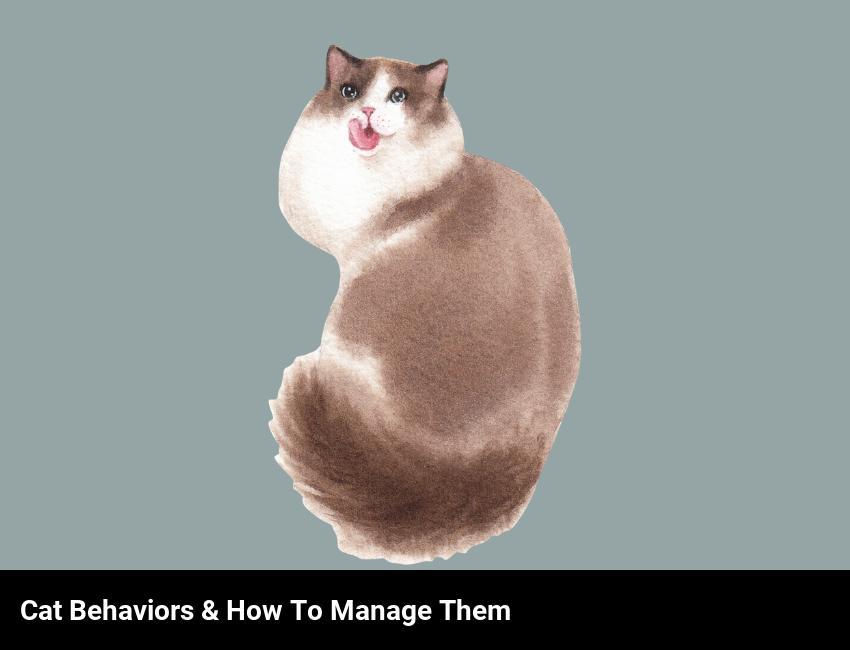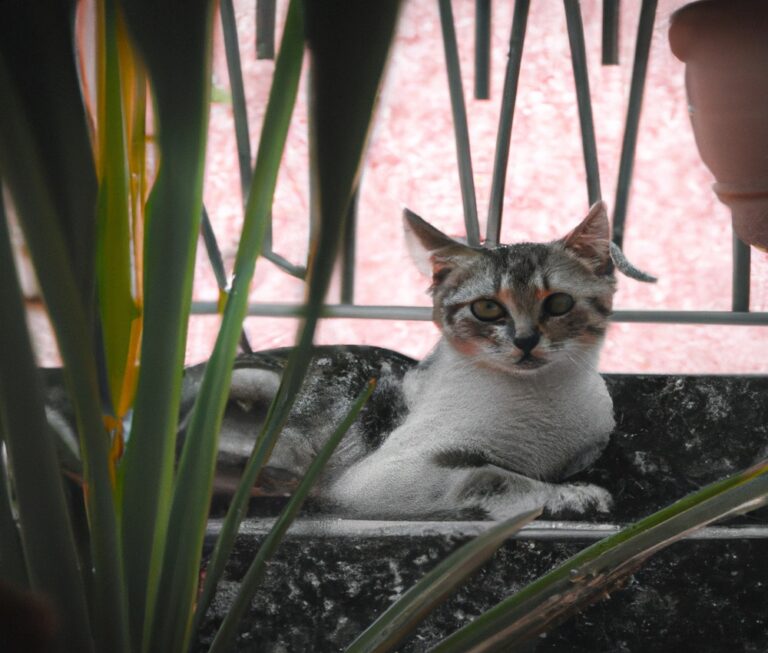The Different Types Of Cat Behavior And How To Handle Them
Cats display a variety of behaviors, such as scratching, meowing, and purring. To handle these behaviors, it’s important to understand what they mean and to provide positive reinforcement. For example, scratching can be redirected to a scratching post and meowing can be addressed by responding with affection. Purring can be encouraged through petting and playtime.
As a cat owner, I know firsthand how complicated cats can be. They have a wide range of behaviors that can be difficult to interpret and handle. From their various vocalizations to their body language, cats have a unique way of expressing themselves. It can be tricky to understand exactly what they’re trying to say and do.
In this blog, I’ll discuss the different types of cat behavior and how to manage them. We’ll explore the common signs of stress in cats, how to identify aggressive behavior, the benefits of positive reinforcement, and how to effectively deal with unwanted behavior. Whether you’re a seasoned cat owner or completely new to the world of cats, this blog will provide valuable insight into understanding and handling their behavior.
What are the different types of cat behavior?
Are you curious about the different types of cat behavior? Cats are complex creatures, and it’s important to understand the different types of behaviors they may exhibit in order to be a responsible pet owner.
First, there are communication behaviors. Cats communicate a variety of things using body language, vocalizations, and scent. If your cat is rubbing against you or purring, they may be trying to show affection. If they’re arching their back or hissing, they’re likely trying to communicate that they’re feeling threatened.
Second, there are grooming behaviors. Cats spend a great deal of time grooming themselves and other cats in order to keep clean and free of parasites. Your cat may also groom you as a way of expressing affection.
Third, there are play behaviors. Cats are naturally curious and playful, and play helps them to build muscle, hone their hunting skills, and bond with their owners. Playing with your cat is a great way to give them mental and physical stimulation.
Finally, there are hunting behaviors. Cats are natural hunters and will often stalk, pounce, and kill small prey such as birds and mice. If you’re concerned about your cat’s hunting behavior, you can provide them with toys or puzzles to help them channel their energy.
Understanding the different types of cat behavior can help you to be a responsible pet owner. Knowing how to respond to your cat’s behavior can help to ensure that your cat is well cared for and happy.
How to identify aggressive behavior in cats?
Identifying aggressive behavior in cats can be tricky, but with a few key signs, you can easily spot if your cat’s feeling feisty. Here are a few tips to help you out:
- Hissing and Growling: If your cat is hissing and growling, it’s an obvious sign of aggression. Keep an eye out for these sounds, and remove yourself or anyone else from the situation immediately if you hear them.
- Flattened Ears and Dilated Pupils: When cats are feeling aggressive, their ears will flatten against the sides of their head, and their pupils will dilate. If you notice either of these signs in your cat, be sure to give them some space and try to calm them down.
- Flicking Tail: If your cat’s tail is flicking back and forth, it’s a sign that they’re feeling threatened and may need some space.
- Stiff Posture: Cats will often stiffen their posture when they’re feeling aggressive. If your cat is standing unusually still, be sure to watch out for any aggressive behavior.
- Swatting: If your cat swats at you or anyone else, it’s a sure sign of aggression. Make sure you give them some space, and try to distract them with a toy or treat if you can.
By keeping an eye out for these signs, you can easily identify when your cat is feeling aggressive and take the necessary steps to keep everyone safe.
How to reduce fearful behavior in cats?
Get to know your cat: Spend time with your cat and observe their behavior. Knowing what triggers their fearful behavior can help you address it more effectively.
- Create a safe environment: Make sure your kitty has a space that feels safe and secure. Provide them with plenty of hiding places and toys to keep them occupied.
- Introduce new things gradually: When introducing new things to your cat, do so gradually. Start small and give them time to get used to the new environment and items.
- Provide positive reinforcement: Use positive reinforcement such as treats and praise when your cat behaves as expected. This will help to encourage the desired behavior and reduce their fearful behavior.
- Be patient: Fearful behavior can take time to reduce. Be patient and consistent in addressing the issue and reward your cat for their efforts.
What are the benefits of positive reinforcement with cats?
Positive reinforcement with cats can have a variety of benefits, including reduced behavioral problems, improved relationships with humans, and increased opportunities to learn.
- Positive reinforcement is a type of training that uses rewards to reinforce desirable behaviors and discourage undesirable behaviors. Rewards can be verbal praise, treats, toys, or other items that cats find rewarding.
- Positive reinforcement can help cats learn new behaviors such as coming when called, walking on a leash, and using a scratching post instead of furniture.
- Positive reinforcement can also help cats become comfortable with humans, reducing fear and aggression.
- Cats who are rewarded for desirable behavior are more likely to display that behavior again in the future, leading to a more positive relationship between cat and human.
- Positive reinforcement can help cats become more confident and secure, leading to a happier and healthier life.
How to effectively deal with unwanted cat behavior?
Unwanted cat behavior can be challenging to deal with, but there are several ways you can manage it effectively:
- Start by understanding the root cause of the behavior. Knowing the reason why your cat is acting out can help you tackle the issue more effectively.
- Use positive reinforcement techniques. Rewarding your cat with treats or verbal praise when they behave appropriately can encourage them to behave the way you want.
- Provide a stimulating environment. If your cat is bored, they might act out in search of entertainment. Providing them with plenty of toys, scratching posts, and other activities can help keep them occupied and happy.
- Spend time with your cat. Showing your cat affection and spending quality time with them can help them feel more secure and loved.
- Seek professional help. If none of the above methods seem to be helping, it’s best to ask a vet or animal behavior specialist for advice. They can provide further insight and help you find the best way to manage your cat’s behavior.
What are the common signs of stress in cats?
If you’ve ever wondered why your cat behaves differently at times, chances are they’re feeling stressed. Stress in cats can manifest itself in a number of ways, so it’s important to be aware of the signs. Here are some of the most common signs of stress in cats.
Changes in Appetite: Cats that are feeling stressed may alter their eating habits. They may eat more, less, or change their preference in food. If you’ve noticed any changes in your cat’s eating habits, it may be a sign of stress.
Hiding or Avoidance: When cats are feeling overwhelmed, they may choose to hide or avoid the source of stress. If your cat is suddenly seeking out quiet, dark places to hide or avoiding certain people or animals, it may be a sign that they’re feeling overwhelmed.
Pacing: If your cat is pacing back and forth or constantly moving around, they may be feeling anxious or stressed.
Excessive Meowing: If your cat is meowing more than usual, it may be a sign of stress.
Inappropriate Urination or Defecation: In extreme cases, cats may urinate or defecate outside the litter box when feeling stressed.
Changes in Grooming Habits: Cats that are feeling stressed may groom themselves more or less than usual.
If you’ve noticed any of these signs of stress in your cat, it’s important to take action. Identifying the source of stress and taking steps to reduce it can help improve your cat’s mental health and overall wellbeing.

Frequently Asked Questions
What signs can indicate that your cat is feeling a certain emotion?
Signs that your cat is feeling a certain emotion include changes in body language, vocalizations, and activity levels. Your cat may show signs of happiness by purring, kneading, or rubbing their head against you. If your cat is feeling anxious, they may display signs such as dilated pupils, flattened ears, or a tucked tail. If your cat is feeling scared, they may hide, meow, or hiss. Observing your cat’s behavior can give insight into their emotions and help you better understand how to handle them.
What are some creative ways to keep your cat from exhibiting unwanted behaviors?
There are a few creative ways to keep your cat from exhibiting unwanted behaviors. For instance, you can try providing your cat with plenty of enrichment activities like scratching posts, hiding spaces, and interactive toys. You can also reward your cat for exhibiting desirable behaviors with treats or praise. Lastly, avoid punishing your cat for unwanted behaviors, instead redirect their attention to something more desirable. With these tips, you can help your cat learn how to behave in a healthy and positive way.
Are there any behavior triggers that may be causing your cat to act out?
Yes, there are many behavior triggers that may be influencing your cat’s behavior. You should look for clues in the environment to identify the cause of your cat’s misbehavior. Common triggers include new pets, changes in routine, loud noises, or unfamiliar people. Learning to recognize these potential triggers can help you create a positive environment for your cat and prevent unwanted behaviors.







